
More Christmas decorations! Don't they look surreal in daylight?


The building next to
Meinl looks extraordinary too - notice those statues!

Gorgeous entrance!
.

Gucci anyone?
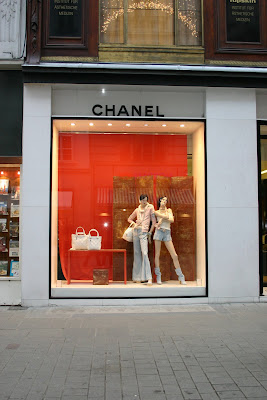
Chanel ma belle! I dare anyone to go out in Vienna with those shorts!
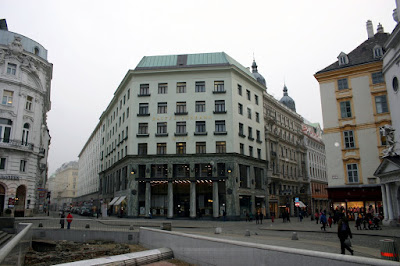
The Adolf Loos building in daylight.
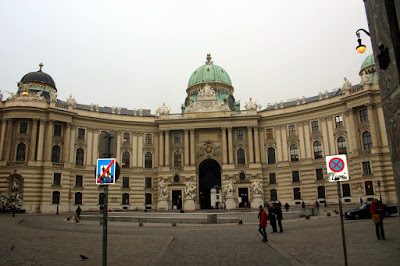 Michaelertor
Michaelertor:
Hofburg main entrance
 Michaelertor
Michaelertor - Hercules statues
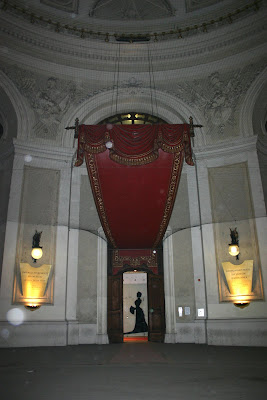
Entrance to Imperial
Apartments - that's Empress Sissy's silhouette

In Der Burg courtyard - monument to emperor Franz

The back of the
Burgkapelle (13
th century) in the
Sweizerhof (oldest part of the
Hofburg, 13
th century)
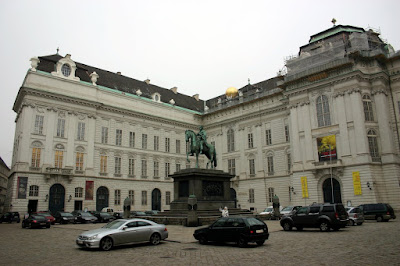 Josefsplatz
Josefsplatz with the monument of
Joseph II, Holy Roman Emperor (1795-1806, by sculptor
Franz Anton Zauner). At the back is the
Prunksaal, part of the
Austrian National Library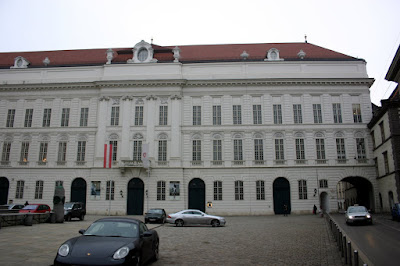
The
Spanish Riding School entrance.

Twin museums(yes it is snow): The
Naturhistorisches Museum opposite of...

...the
Kunsthistorisches Museum!

Horse statue at Maria-
Theresien Platz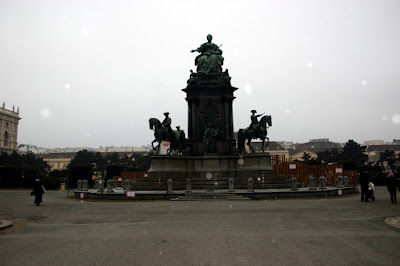
Maria-
Theresien statue

The
Museumsquartier, which includes...

...the white
Leopold (by architects
Ortner & Ortner)...
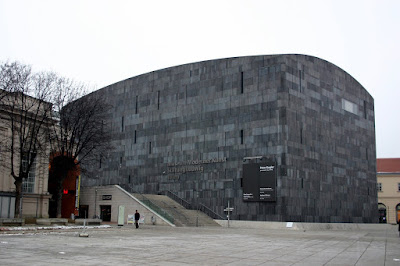
...and the black monolithic
MUMOK made of lava blocks(also by architects
Ortner & Ortner).

A lovely Renaissance style building.
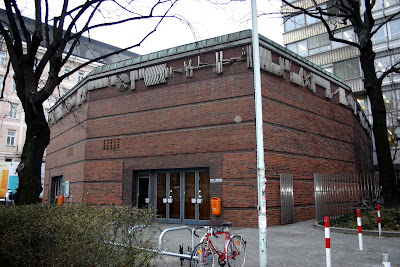
A brick-clad building, used as an auditorium for the University. Check the metallic details.

Secession then! This exhibition space, designed by architect and designer
Joseph M. Olbrich to house artworks and exhibitions from the
Secession artists in Vienna: Klimt,
Koloman Moser, Josef Hoffman and many more.The building is a far cry from the rest of the
Ringstrasse, simple, small and elegant, with only a golden leaf dome on the top a sign of restrained extravagance (if one can say that). one of the reasons it is called "golden cabbage" by some locals.

The entrance is impressive, with ivy leaves designed around it and golden details - I shivered thinking about the artists that had crossed this very threshold to enter. I had come mainly to see the
Beethoven frieze, one of the biggest and most impressive works of Gustaf Klimt, which is now permanently displayed here. No photos were allowed, so I will post below some taken from the official website.

First wall of the frieze - the Golden Knight (Armoured Strength with Ambition and Sympathy)

Second wall: The Hostile Forces

Third wall - part one: Poetry

Third wall part two: the Arts, Choir of Angels and Embracing Couple (Kiss of the World).
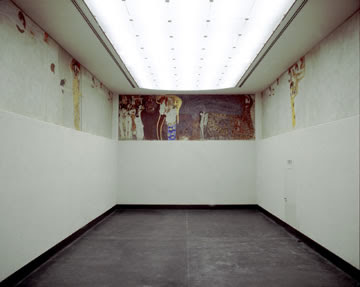
The exhibition space of the frieze - remember it was inspired by Beethoven's 9th symphony
The Beethoven Frieze was originally intended as an ephemeral work of art and, like the other decorative paintings, it was to be removed after the close of the exhibition. It was only owing to fortunate circumstances, that the frieze was not destroyed as planned: the Secession was to present the following year a major Klimt retrospective (
XVIIIth exhibition, 1903), and it was decided to leave the work of art in place. After passing through a couple of owners, in 1973 the Beethoven Frieze was purchased by the Republic of Austria and restored over the course of ten years. Finally, in the course of the general renovation of the Secession in 1985, a room was created in the basement for the Beethoven Frieze. The dimensions of this room exactly correspond to the
climate controlled space required for the frieze for reasons of conservation, and here the frieze can be shown separately from ongoing exhibitions. Since 1986 the wall cycle has again been made permanently accessible to the public at the Secession as a loan from the
Österreichische Galerie Belvedere. It is a sight not to be missed, along with the accompanying sketches exhibited there and the history of the building in the antechamber.
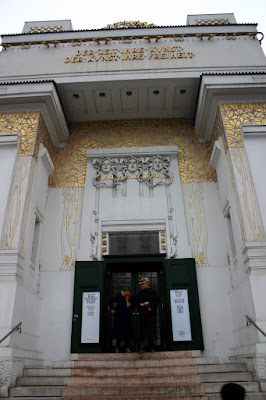
Entrance of the Secession building
The building keeps seving its original purpose as an exhibition space -
the one I saw there was by US artist
Sharon Lockhart, called Lunch Break. Over the last 15 years she has made films and photographs that frame moments of everyday life while exploring the subtle relationships between the two mediums. Shown for the first time at the Secession, Lockhart’s latest films and accompanying photographic series describe a specific place and time: Maine’s Bath Iron Works at the start of the 21st century. Lockhart spent the last year looking at the lives of workers in the historic shipyard and each of the five projects included in the exhibition examines a different element of their everyday experience. A very interesting show indeed - especially the lunch box portraits (below) and the projected film.
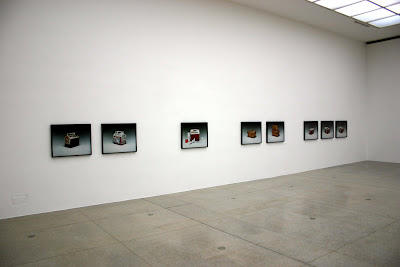

Moving on, I passed in front of the famous
Musikverein (above), one of the most famous concert halls of the world, seat of the Vienna Philharmonic, (with the famous New Year's Concert) ,the Wiener Symphoniker and the Radio Symphony Orchestra.
 Otto Wagner
Otto Wagner is the architect most linked to Vienna: he transformed the whole city in the 19th century, with his master plan for everything: building, transportations, amenities. His Metropolitan stations, elegantly designed in Jugendstil (or Art Nouveau) are scattered in the city, some still in use (like the one below) and some turned into something else, like the
Karlplatz Pavillion cafe above.

Under the Karsplatz there is a huge underground passage, where there is an amazing work of art installed, using mirrors and led numbers that give you "useless" statistical information, like for example the number π, seen below. The information that the numbers give you though may lead to interesting thoughts while one passes by (I immediately thought of Kate Bush and her π song!).

But what is the artwork? The
media installation Pi by the Canadian artist
Ken Lum. A team experienced in art production developed, over a period of several months, the individual details together with the artist and the architect overseeing construction on site. A group of social scientists from the
SORA Institute did the groundwork for the digital programming of statistic data sets which are now permanently shown on LED displays. This process initiated in a dialogue with the internationally active artist Ken Lum (who also spends a lot of time travelling) and the curators thus requiring a trans-disciplinary communication over an extended period of time within a large, constantly growing production team. Both in this respect and on the technical level as well as in terms of the scientific work done, the media installation Pi can be seen as an extraordinary example of contemporary art production, well suited for setting standards for art in public space. Oh, and there is a club at the underground passages too, named (what else?)
Club U. Walking further to reach the Untere Belvedere, I saw the
Akademietheater (which now hosts part of the repertoire of the
Burgtheater) from afar:

After seeing the frieze earlier in the day, I had decided to see more Klimt - I knew there was a show centered around him currently in Vienna, so I headed towards the
Unteres Belvedere to see it.
Schloss Belvedere is considered one of the world's finest Baroque palaces, designed by a master of the kind, Johann Lukas von Hildebrandt for Prince Uegene of Savoy, the man who masterminded the victory against the Turks in 1718, becoming a hero for Vienna. The
Unteres (lower) Belvedere was built first, as a summer residence, and a long garden rivalling the Versailles connects it with the
Oberes (upper) Belvedere, the main palace. Both now serve as museums, with extraordinary collections, which include works by Klimt.
 Entrance of Unteres Belvedere
Entrance of Unteres Belvedere The Unteres Belvedere main building
The Unteres Belvedere main buildingAround the time of my visit, a magnificent show was under way:
the recreation of the 1908 Kunstschau due to its 100th anniversary. Part of the original exhibits - which were partly presented in replicas of the former exhibition rooms and additional works by artists that were presented at the Kunstschau 1908 as well as documentary photographs, models, original plans, and a film, illustrated the details and dimensions of this extraordinary event. An architectural model made of wood demonstrated in amazing detail the location of the Kunstschau premises within their urban context. Of course the main attraction of the original show, as well as it's re-incarnation, was “Room 22” which was designed by
Koloman Moser using major works by Gustav Klimt.
 The recreated Klimt room.
The recreated Klimt room.
Among other works, Gustav Klimt presented:
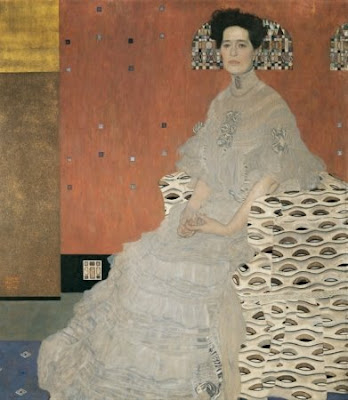
Fritza Riedler (1906)
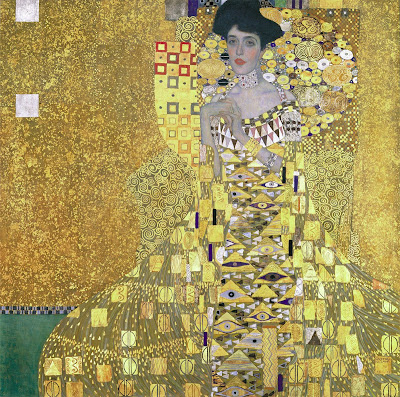 Adele Bloch-Bauer I (1907)
Adele Bloch-Bauer I (1907)
(a black and white copy was presented as the original is in New York in a private gallery)

The Three Ages of Woman (1905)
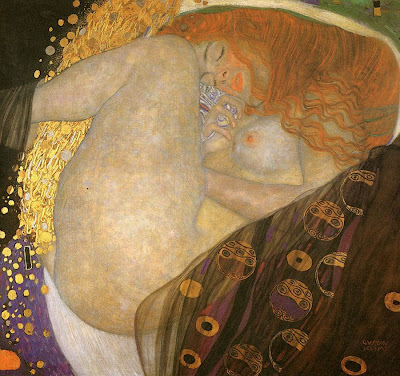
Danaë (1907/08)
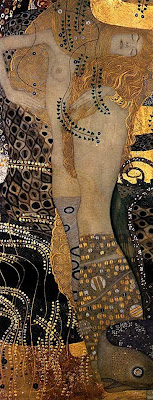
Wasserschlangen I (1904/07)

The Medezin mural
(1900/07, depicted in black and white since the original was destroyed by the Nazis - here a detail showing Health)
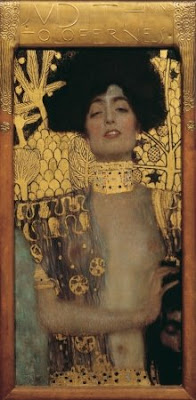
Judith I (1901)
and his most famous work The Kiss (1908), which was acquired for the collection now housed in the Belvedere while the exhibition was still running. I cannot describe in words the feeling that overwhelmed me when finally facing the Kiss for the first time. It is one of these rare works of art that defy any description and make you stand there humble and helpless to grasp their full extend, but at the same time pulling you inside them and help you rise to higher levels. Amazing experience indeed. I did not want to leave the room. Unfortunately no photos allowed again (and the Kiss had a guard positioned right next to it) so the photo below is not mine.

Having enjoyed both the exhibition and the walk to and from the Belvedere, I had a good walk around the downtown shops of Vienna. I had a coffe at Sacher, along with a piece of the famous Sacher torte, but did not sit at the stuffy old cafe, but at it's younger sibling, Sacher Eck: no tourists, much more modern and quiet, same excellent coffe and desserts. Shopping turned out good: sales were still on, and soon I found myself with a gorgeous pair of Hugo Boss black shoes (a steal under 100 Euros at the Humanic), a Benetton turtleneck (unfortunately not the orange one I coveted) and the most gorgeous piece of all: a plaid shirt in green and yellow at an amazing little shop called
Dick And Jane. This is a relatively new clothing brand in Austria which merits its own post.
 Walking past the Viennese Opera!
Walking past the Viennese Opera! Some Christmas decoration left-overs...
Some Christmas decoration left-overs...After a quick shower and change (plaid shirt and new shoes on!) I headed towards my date with the
Taylor couple and their friends Chris and Denise, for dinner at Schnitzelwirt (Neubaugasse 52) to eat, what else, schnitzel! The portions are incredible (two huge schnitzels), the cooking excellent, the place is very traditional and cozy (the narrowness of it helps I guess) and the company was great - all elements of a perfect dinner! We headed next to a lovely Turkish bar for drinks, ending the night in the best possible way.
















